
Futurism - I
Rayonism
Precisionism
Giacomo Balla 1871 – 1958
Carlo Carra 1881 – 1966
Umberto Boccioni 1882 – 1916
Gino Severini 1883 - 1966
Natalia Goncharova 1881 – 1962 (Rayonism)
Georgia O'Keeffe 1887 - 1986 (Precisionism)
Futurism influenced the art movements Art Deco, Constructivism, Surrealism, Dada,
and to a greater degree Precisionism, Rayonism, and Vorticism.
Futurism
Futurism (Italian: Futurismo) was an artistic and social movement that originated in Italy in the early 20th century. It emphasized speed, technology, youth, and violence, and objects such as the car, the aeroplane, and the industrial city. Although it was largely an Italian phenomenon, there were parallel movements in Russia, England, Belgium and elsewhere. The Futurists practiced in every medium of art, including painting, sculpture, ceramics, graphic design, industrial design, interior design, urban design, theatre, film, fashion, textiles, literature, music, architecture, and even Futurist meals. Its key figures were the Italians Filippo Tommaso Marinetti, Umberto Boccioni, Carlo Carrà, Gino Severini, Giacomo Balla, Antonio Sant'Elia, Bruno Munari, Benedetta Cappa and Luigi Russolo, the Russians Natalia Goncharova, Velimir Khlebnikov, Igor Severyanin, David Burliuk, Aleksei Kruchenykh and Vladimir Mayakovsky, the Belgian Jules Schmalzigaug and the Portuguese Almada Negreiros. It glorified modernity and aimed to liberate Italy from the weight of its past. Cubism contributed to the formation of Italian Futurism's artistic style. Important Futurist works included Marinetti's Manifesto of Futurism, Boccioni's sculpture Unique Forms of Continuity in Space, and Balla's painting Abstract Speed + Sound (pictured). To some extent Futurism influenced the art movements Art Deco, Constructivism, Surrealism, Dada, and to a greater degree Precisionism, Rayonism, and Vorticism.
Futurism is an avant-garde movement founded in Milan in 1909 by the Italian poet Filippo Tommaso Marinetti. Marinetti launched the movement in his Futurist Manifesto, which he published for the first time on 5 February 1909 in La gazzetta dell'Emilia, an article then reproduced in the French daily newspaper Le Figaro on Saturday 20 February 1909. He was soon joined by the painters Umberto Boccioni, Carlo Carrà, Giacomo Balla, Gino Severini and the composer Luigi Russolo. Marinetti expressed a passionate loathing of everything old, especially political and artistic tradition. "We want no part of it, the past", he wrote, "we the young and strong Futurists!" The Futurists admired speed, technology, youth and violence, the car, the airplane and the industrial city, all that represented the technological triumph of humanity over nature, and they were passionate nationalists. They repudiated the cult of the past and all imitation, praised originality, "however daring, however violent", bore proudly "the smear of madness", dismissed art critics as useless, rebelled against harmony and good taste, swept away all the themes and subjects of all previous art, and gloried in science.
Publishing manifestos was a feature of Futurism, and the Futurists (usually led or prompted by Marinetti) wrote them on many topics, including painting, architecture, religion, clothing and cooking.
The founding manifesto did not contain a positive artistic programme, which the Futurists attempted to create in their subsequent Technical Manifesto of Futurist Painting (1914). This committed them to a "universal dynamism", which was to be directly represented in painting. Objects in reality were not separate from one another or from their surroundings: "The sixteen people around you in a rolling motor bus are in turn and at the same time one, ten four three; they are motionless and they change places. ... The motor bus rushes into the houses which it passes, and in their turn the houses throw themselves upon the motor bus and are blended with it."
Giacomo Balla
1871 – 1958

Giacomo Balla
(18 July 1871 – 1 March 1958) was an Italian painter, art teacher and poet best known as a key proponent of Futurism. In his paintings he depicted light, movement and speed. He was concerned with expressing movement in his works, but unlike other leading futurists he was not interested in machines or violence with his works tending towards the witty and whimsical.
Giacomo Balla was born in Turin, in the Piedmont region of Italy. He was the son of a photographer[2] and as a child studied music.
At age nine, after the death of his father, he gave up music and began working in a lithograph print shop. By age 20, his interest in visual art had developed to such a level that he decided to study painting at local academies, and several of his early works were shown at exhibitions. Following academic studies at the University of Turin, Balla moved to Rome in 1895, where he met and later married Elisa Marcucci. For several years he worked in Rome as an illustrator, caricaturist and portrait painter. In 1899, his work was exhibited at the Venice Biennale, and in the ensuing years his art was shown at major exhibitions in Rome and Venice, as well as in Munich, Berlin and Düsseldorf, at the Salon d'Automne in Paris, and at galleries in Rotterdam.
Around 1902, he taught Divisionist techniques to Umberto Boccioni and Gino Severini. Influenced by Filippo Tommaso Marinetti, Giacomo Balla adopted the Futurism style, creating a pictorial depiction of light, movement and speed. He was a signatory of the Futurist Manifesto in 1910. Typical for his new style of painting is Dynamism of a Dog on a Leash (1912) and his 1914 work Abstract Speed + Sound (Velocità astratta + rumore). In 1914, he began to design Futurist furniture, as well as so-called Futurist "antineutral" clothing. Balla also began working as a sculptor, creating, in 1915, the well-known work titled Boccioni's Fist, based on 'lines of force' (Linee di forza del pugno di Boccioni).
During World War I, Balla's studio became a meeting place for young artists.
In 1935, he was made a member of Rome's Accademia di San Luca.
In 1955, Balla participated in the documenta 1 in Kassel.
He died on 1 March 1958.

Giacomo Balla, 1912, Dinamismo di un Cane al Guinzaglio (Dynamism of a Dog on a Leash)

Giacomo Balla, Street Light (1909)
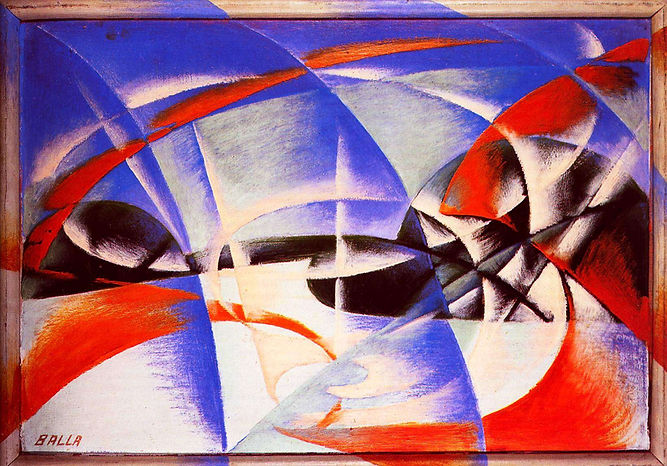
Landscape
Giacomo Balla
1913
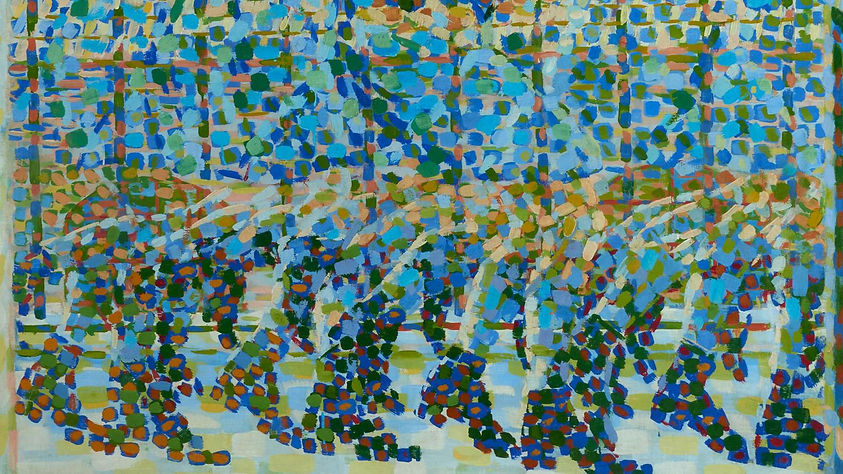
GIACOMO BALLA: YOUNG GIRL RUNNING ON A BALCONY 1912. Milan.

Speeding Automobile
Giacomo Balla
1912

Abstract Speed
Giacomo Balla
1913
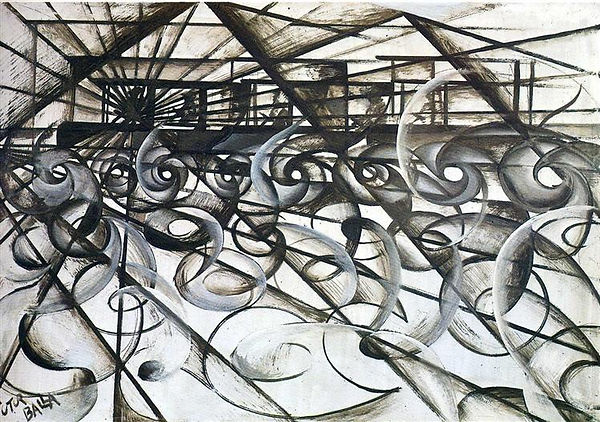
Velocity Of An Automobile
Giacomo Balla
1913

Planet Mercury passing in front of the Sun
Giacomo Balla
1914

Design for Living Room Furnishings
Giacomo Balla
1918

Giacomo Balla, 1912, Dinamismo di un Cane al Guinzaglio (Dynamism of a Dog on a Leash)
Carlo Carra
1881 – 1966

Carlo Carra
(February 11, 1881 – April 13, 1966) was an Italian painter and a leading figure of the Futurist movement that flourished in Italy during the beginning of the 20th century. In addition to his many paintings, he wrote a number of books concerning art. He taught for many years in the city of Milan.
Carrà was born in Quargnento, near Alessandria (Piedmont). At the age of 12 he left home in order to work as a mural decorator.
In 1899–1900, Carrà was in Paris decorating pavilions at the Exposition Universelle, where he became acquainted with contemporary French art. He then spent a few months in London in contact with exiled Italian anarchists, and returned to Milan in 1901. In 1906, he enrolled at Brera Academy (Accademia di Brera) in the city, and studied under Cesare Tallone. In 1910 he signed, along with Umberto Boccioni, Luigi Russolo and Giacomo Balla the Manifesto of Futurist Painters, and began a phase of painting that became his most popular and influential.
Carrà's Futurist phase ended around the time World War I began. His work, while still using some Futurist concepts, began to deal more clearly with form and stillness, rather than motion and feeling. Inspired by Trecento painting, children's art, and the work of Henri Rousseau, Carrà soon began creating still lifes in a simplified style that emphasized the reality of ordinary objects. In 1917 he met Giorgio de Chirico in Ferrara, and worked with him there for several weeks. Influenced by de Chirico, Carrà began including mannequin imagery in his paintings.[2] The two artists were the innovators of a style they called "metaphysical painting". By 1919, Carrà's metaphysical phase was giving way to an archaicism inspired by the works of Giotto, whom he admired as "the artist whose forms are closest to our manner of conceiving the construction of bodies in space." Carrà's painting The Daughters of Lot (1919) exemplifies the new direction of his work. He was among the contributors of the Rome-based literary magazine La Ronda between 1919 and 1922. Throughout the 1920s and 1930s, he concentrated mainly on landscape painting and developed a more atmospheric style. An example from this period is his 1928 Morning by the Sea.
He is best known for his 1911 Futurist work, The Funeral of the Anarchist Galli. Carrà was indeed an anarchist as a young man but, along with many other Futurists, later held more reactionary political views, becoming ultranationalist and irredentist before and during the war. He supported fascism after 1918. In the 1930s, Carrà signed a manifesto in which called for support of the state ideology through art. The Strapaese group he joined, founded by Giorgio Morandi, was strongly influenced by fascism and responded to the neo-classical guidelines which had been set by the regime after 1937, but was opposed to the ideological drive towards strong centralism.
Carrà died in Milan in 1966.
.jpg)
CARLO CARRA The Metaphysical Muse

Carlo Carra, Mother and Son, 1917

Carlo Carra,
NATURA MORTA METAFISICA

Carlo Carra,
FUNÉRAILLES DE L ANARCHISTE GALLI

Carlo Carra,
FILIPPO TOMMASO MARINETTI

Carlo Carra,
LAISSANT LE THÉÂTRE

Carlo Carra,
LE CAVALIER DE L APOCALIPSE

Carlo Carra,
DONNA CHE SI ASCIUGA

Carlo Carra,
NOTTURNO UNE PIAZZA BECCARIA DI MILANO

Carlo Carra,
IL FIGLIO DEL COSTRUTTORE

Carlo Carra,
LA CAMÉRA INCANTATA

Carlo Carra,
SIMULTANEITÀ-LA DONNA AL BALCONE

Carlo Carra,
CHEVAL ET MOTARD

Carlo Carra,
L OVALE DELLE APPARIZIONI
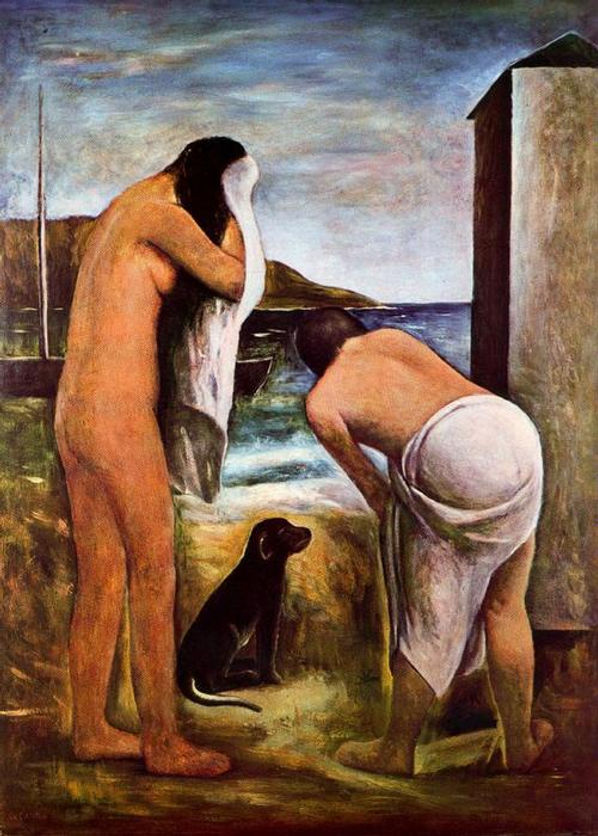
Carlo Carra,
PROPRIÉTÉ

Carlo Carra,
DI PORTO LO

Carlo Carra,
LE FIGLIE DI LOTH

Carlo Carra,
NUOTATRICI

Carlo Carra,
LE `GALLERIA` DANS MILAN

Carlo Carra,
LE FIGLIE DI LOTH
Umberto Boccioni
1882 – 1916

Umberto Boccioni (19 October 1882 – 17 August 1916) was an influential Italian painter and sculptor. He helped shape the revolutionary aesthetic of the Futurism movement as one of its principal figures. Despite his short life, his approach to the dynamism of form and the deconstruction of solid mass guided artists long after his death. His works are held by many public art museums, and in 1988 the Metropolitan Museum of Art in New York City organized a major retrospective of 100 pieces.

The City Rises by Umberto Boccioni 1910

The Laugh, 1911 by Umberto Boccioni
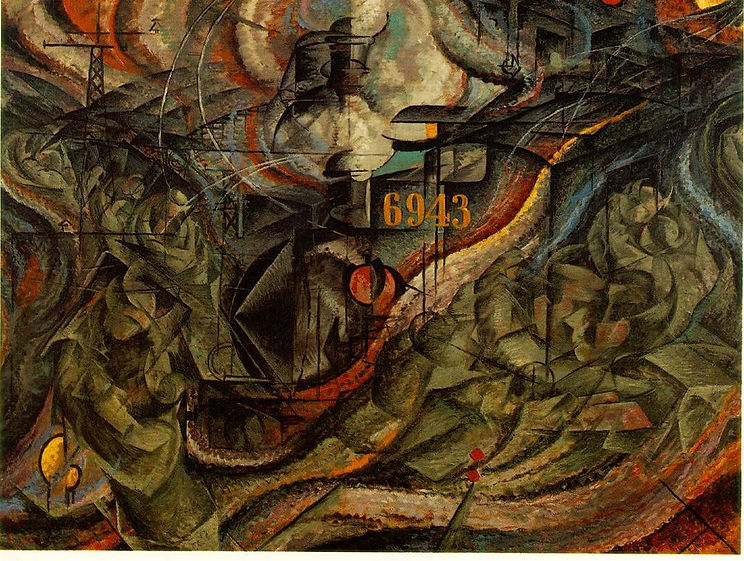
States of Mind I:The Farewells, 1911 by Umberto Boccioni

States of Mind III; Those Who Stay, 1911 by Umberto Boccioni

Modern Idol, 1911 by Umberto Boccioni

The Street Enters the House, 1911 by Umberto Boccioni
%2C.jpg)
Visioni simultanee, 1912 by Umberto Boccioni
%2C_.jpg)
Elasticity, 1912 by Umberto Boccioni

Head + House + Light, 1912, sculpture destroyed by Umberto Boccioni
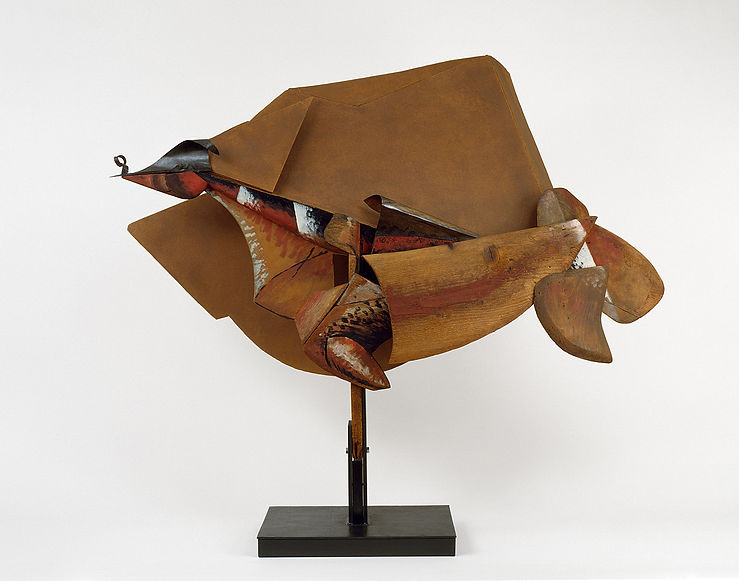
UMBERTO BOCCIONI
THE DYNAMISM OF y RACEHORSE. 1914-1915 Venice. Peggy Guggenheir, Collection

UMBERTO BOCCIONI
Dynamism of a Man's Head, 1913

UMBERTO BOCCIONI
Horizontal Volumes, 1915

UMBERTO BOCCIONI
Charge of the Lancers, 1915
.jpg)
UMBERTO BOCCIONI
Portrait of Ferruccio Busoni, 1916
Gino Severini
1883 - 1966
Gino Severini (7 April 1883 – 26 February 1966) was an Italian painter and a leading member of the Futurist movement. For much of his life he divided his time between Paris and Rome. He was associated with neo-classicism and the "return to order" in the decade after the First World War. During his career he worked in a variety of media, including mosaic and fresco. He showed his work at major exhibitions, including the Rome Quadrennial, and won art prizes from major institutions.
Severini was born into a poor family in Cortona, Italy. His father was a junior court official and his mother a dressmaker. He studied at the Scuola Tecnica in Cortona until the age of fifteen, when he and a group of fellow-classmates were expelled from the entire Italian school system for the attempted theft of exam papers. The boys escaped a custodial sentence but Severini never again attended formal education. For a while he worked with his father; then in 1899 he moved to Rome with his mother. It was there that he first showed a serious interest in art, painting in his spare time while working as a shipping clerk. With the help of a patron of Cortonese origins he attended art classes, enrolling in the free school for nude studies (an annex of the Rome Fine Art Institute) and a private academy. His formal art education ended after two years when his patron stopped his allowance, declaring, "I absolutely do not understand your lack of order."
In 1900 he met the painter Umberto Boccioni. Together they visited the studio of Giacomo Balla, where they were introduced to the technique of Divisionism, painting with adjacent rather than mixed colors and breaking the painted surface into a field of stippled dots and stripes. The ideas of Divisionism had a great influence on Severini's early work and on Futurist painting from 1910 to 1911.
Severini settled in Paris in November 1906. The move was momentous for him. He said later, "The cities to which I feel most strongly bound are Cortona and Paris: I was born physically in the first, intellectually and spiritually in the second." He lived in Montmartre and dedicated himself to painting. There he met most of the rising artists of the period, befriending Amedeo Modigliani and occupying a studio next to those of Raoul Dufy, Georges Braque and Suzanne Valadon. He knew most of the Parisian avant-garde, including Jean Metzinger, Albert Gleizes, Juan Gris, Pablo Picasso, Lugné-Poe and his theatrical circle, the poets Guillaume Apollinaire, Paul Fort, Max Jacob, and author Jules Romains. The sale of his work did not provide enough to live on and he depended on the generosity of patrons.
.jpg)
Self-portrait
Gino Severini
1912

Gino Severini, 1910–11, La Modiste (The Milliner)

Gino Severini, 1911, Souvenirs de Voyage (Memories of a Journey, Ricordi di viaggio)

Gino Severini, 1912, Dynamic Hieroglyphic of the Bal Tabarin
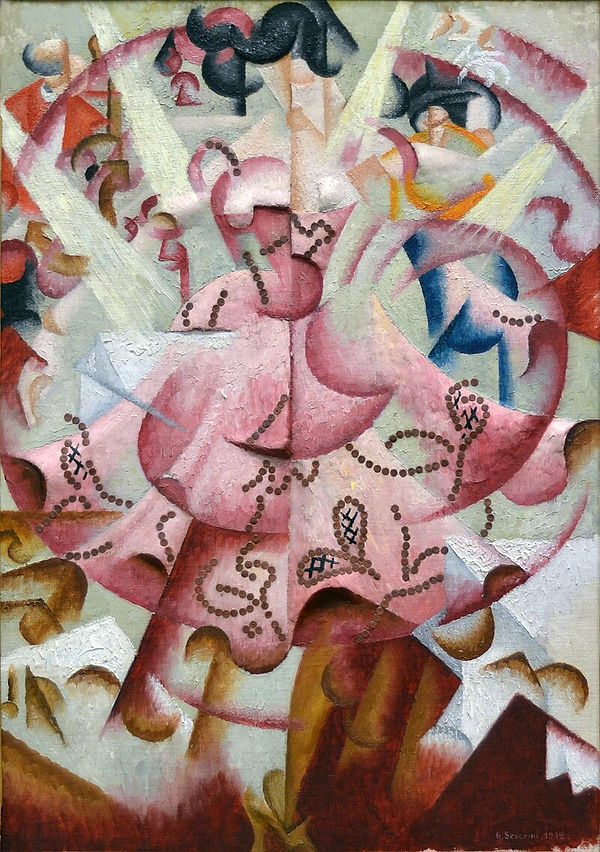
Gino Severini, 1912, Dancer at Pigalle

Gino Severini, La Danseuse Obsedante (The Haunting Dancer, Ruhelose Tanzerin), 1911

Gino Severini, Le Boulevard, 1911

On the Beach
Gino Severini
c.1948

Dynamism of a Dancer (Dinamismo di una danzatrice, Ballerina di chahut), 1912

Gino Severini, Nature morte à la guitare, 1919

Gino Severini, Bohémien Jouant de L'Accordéon (The Accordion Player), 1919

Two Punchinellos
Gino Severini
1922

Odalisque with Mirrors
Gino Severini
1942

Portrait of Madame M.S.
Gino Severini
Natalia Goncharova
1881 – 1962
Rayonism
Rayonism
Rayonism (or Rayism or Rayonnism) is a style of abstract art that developed in Russia in 1911.
Mikhail Larionov and Natalia Goncharova developed rayonism after hearing a series of lectures about Futurism by Marinetti in Moscow. The Futurists took speed, technology and modernity as their inspiration, depicting the dynamic character of early 20th century life.
The Rayonists sought an art that floated beyond abstraction, outside of time and space, and to break the barriers between the artist and the public. They derived the name from the use of dynamic rays of contrasting color, representing lines of reflected light — crossing of reflected rays from various objects.
At the 1913 Target exhibition they introduced the style to the public. In their literature they described Rayonism as naturally encompassing all existing styles and forms of the art of the past, as they, like life, are simply points of departure for a Rayonist perception and construction of a picture.
Natalia Sergeevna Goncharova (3 July 1881 – 17 October 1962) was a Russian avant-garde artist, painter, costume designer, writer, illustrator, and set designer. Goncharova's lifelong partner was fellow Russian avant-garde artist Mikhail Larionov. She was a founding member of both the Jack of Diamonds (1909–1911), Moscow's first radical independent exhibiting group, the more radical Donkey's Tail (1912–1913), and with Larionov invented Rayonism (1912–1914). She was also a member of the German-based art movement Der Blaue Reiter. Born in Russia, she moved to Paris in 1921 and lived there until her death.
Her painting vastly influenced the avant-garde in Russia. Her exhibitions held in Moscow and St Petersburg (1913 and 1914) were the first promoting a “new” artist by an independent gallery. When it came to the pre-revolutionary period in Russia, where decorative painting and icons were a secure profession, her modern approach to rendering icons was both transgressive and problematic. She was one of the leading figures in the avant-garde in Russia and carried this influence with her to Paris.
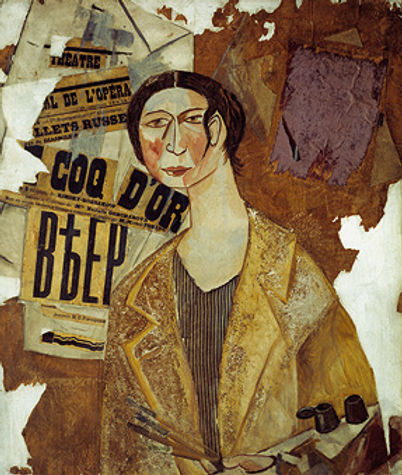
Portrait of Natalia Goncharova by Mikhail Larionov (1915)

Natalia Goncharova
Self-portrait (1907)
.jpg)
Natalia Goncharova
Rayonist Lilies, 1913

Linen
Natalia Goncharova
1908

Natalia Goncharova
Rayonist Lilies, 1913

Natalia Goncharova
Cyclist (1913)

Natalia Goncharova
Costume design for St John (1915)

Haycutting
Natalia Goncharova
1910

Harvest
Natalia Goncharova
1911

Sabbath
Natalia Goncharova
1912

Portrait of Larianov
Natalia Goncharova
1913

Orange Vendor, Spain
Natalia Goncharova
1916

Autumn evening
Natalia Goncharova
1922 - 1928

Liturgy - sketch of a costume
Natalia Goncharova
1914

Liturgy six winged Seraph
Natalia Goncharova
1914

Russian woman's costume from Le coq d'or
Natalia Goncharova
1914
Georgia O'Keeffe
1887 - 1986
Precisionism
Precisionism
Precisionism was a modernist art movement that emerged in the United States after World War I. Influenced by Cubism, Purism, and Futurism, Precisionist artists reduced subjects to their essential geometric shapes, eliminated detail, and often used planes of light to create a sense of crisp focus and suggest the sleekness and sheen of machine forms. At the height of its popularity during the 1920s and early 1930s, Precisionism celebrated the new American landscape of skyscrapers, bridges, and factories in a form that has also been called "Cubist-Realism." The term "Precisionism" was first coined in the mid-1920s, possibly by Museum of Modern Art director Alfred H. Barr although according to Amy Dempsey the term "Precisionism" was coined by Charles Sheeler. Painters working in this style were also known as the "Immaculates", which was the more commonly used term at the time. The stiffness of both art-historical labels suggests the difficulties contemporary critics had in attempting to characterize these artists.

Alfred Stieglitz, Georgia O'Keeffe, platinum print, 1920

GEORGIA O'KEEFFE:
The Shelton with Sunspots (1926)
Georgia O'Keeffe
Georgia Totto O'Keeffe (November 15, 1887 – March 6, 1986) was an American modernist artist. She was known for her paintings of enlarged flowers, New York skyscrapers, and New Mexico landscapes. O'Keeffe has been called the "Mother of American modernism".
In 1905, O'Keeffe began art training at the School of the Art Institute of Chicago and then the Art Students League of New York. In 1908, unable to fund further education, she worked for two years as a commercial illustrator and then taught in Virginia, Texas, and South Carolina between 1911 and 1918. She studied art in the summers between 1912 and 1914 and was introduced to the principles and philosophies of Arthur Wesley Dow, who created works of art based upon personal style, design, and interpretation of subjects, rather than trying to copy or represent them. This caused a major change in the way she felt about and approached art, as seen in the beginning stages of her watercolors from her studies at the University of Virginia and more dramatically in the charcoal drawings that she produced in 1915 that led to total abstraction. Alfred Stieglitz, an art dealer and photographer, held an exhibit of her works in 1917. Over the next couple of years, she taught and continued her studies at the Teachers College, Columbia University.
She moved to New York in 1918 at Stieglitz's request and began working seriously as an artist. They developed a professional and personal relationship that led to their marriage in 1924. O'Keeffe created many forms of abstract art, including close-ups of flowers, such as the Red Canna paintings, that many found to represent vulvas, though O'Keeffe consistently denied that intention. The imputation of the depiction of women's sexuality was also fueled by explicit and sensuous photographs of O'Keeffe that Stieglitz had taken and exhibited.
O'Keeffe and Stieglitz lived together in New York until 1929, when O'Keeffe began spending part of the year in the Southwest, which served as inspiration for her paintings of New Mexico landscapes and images of animal skulls, such as Cow's Skull: Red, White, and Blue and Ram's Head White Hollyhock and Little Hills. After Stieglitz's death, she lived in New Mexico at Georgia O'Keeffe Home and Studio in Abiquiú until the last years of her life, when she lived in Santa Fe. In 2014, O'Keeffe's 1932 painting Jimson Weed/White Flower No. 1 sold for $44,405,000, more than three times the previous world auction record for any female artist. After her death, the Georgia O'Keeffe Museum was established in Santa Fe.

GEORGIA O'KEEFFE: SHELTON HOTEL,
NEW YORK, NO. 1.1926. New York. Kennedy Galleries

GEORGIA O'KEEFFE:
Radiator Building, Night, New York 1927


GEORGIA O'KEEFFE:
New York Night, 1929
GEORGIA O'KEEFFE:
“Ritz Tower,” 1928

GEORGIA O'KEEFFE:
City Night (1926)

Georgia O'Keeffe, Music Pink and Blue, 1918

Georgia O'Keeffe, Series 1, No. 8, 1918

Georgia O'Keeffe, Red Canna, 1919

Georgia O'Keeffe, Grey Line With Black, Blue And Yellow, 1923

Georgia O'Keeffe, Yellow Calla

Georgia O'Keeffe, Red Canna, 1923

Georgia O'Keeffe, Light Iris, 1924

Georgia O'Keeffe, Red Canna 1924

Georgia O'Keeffe, East River from the Shelton, 1928

Georgia O'Keeffe, Iris, 1929
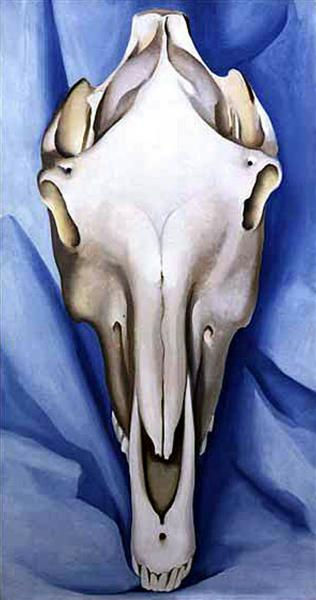
Horse's Skull on Blue
Georgia O'Keeffe
1930

Jack-in-the-Pulpit No. IV
Georgia O'Keeffe
1930

Blue Morning Glories
Georgia O'Keeffe
1935

Ram's Head, White Hollyhock-Hills
Georgia O'Keeffe
1935
Georgia O’Keeffe by Alfred Stieglitz - Hands and Torso

Georgia O'Keeffe and Alfred Stieglitz
Alfred Stieglitz
(January 1, 1864 – July 13, 1946) was an American photographer and modern art promoter who was instrumental over his 50-year career in making photography an accepted art form. In addition to his photography, Stieglitz was known for the New York art galleries that he ran in the early part of the 20th century, where he introduced many avant-garde European artists to the U.S. He was married to painter Georgia O'Keeffe.
.jpg)
Alfred Stieglitz, Georgia O'Keeffe,1918

Alfred Stieglitz, Georgia O'Keeffe

Alfred Stieglitz, Georgia O'Keeffe,1918

Alfred Stieglitz, Georgia O'Keeffe

Alfred Stieglitz, Georgia O'Keeffe,1919

Alfred Stieglitz, Georgia O'Keeffe

Alfred Stieglitz, Georgia O'Keeffe

Alfred Stieglitz, Georgia O'Keeffe

Alfred Stieglitz, Georgia O'Keeffe

Alfred Stieglitz, Georgia O'Keeffe

Alfred Stieglitz, Georgia O'Keeffe

Alfred Stieglitz, Georgia O'Keeffe

Alfred Stieglitz, Georgia O'Keeffe

Alfred Stieglitz, Georgia O'Keeffe

Alfred Stieglitz, Georgia O'Keeffe

Alfred Stieglitz, Georgia O'Keeffe

Alfred Stieglitz, Georgia O'Keeffe

Alfred Stieglitz, Georgia O'Keeffe

Alfred Stieglitz, Georgia O'Keeffe

Alfred Stieglitz, Georgia O'Keeffe

Alfred Stieglitz, Georgia O'Keeffe,1920

Alfred Stieglitz, Georgia O'Keeffe

Alfred Stieglitz, Georgia O'Keeffe.

Alfred Stieglitz, Georgia O'Keeffe

Alfred Stieglitz, Georgia O'Keeffe

Alfred Stieglitz, Georgia O'Keeffe

Alfred Stieglitz, Georgia O'Keeffe

Alfred Stieglitz, Georgia O'Keeffe

Alfred Stieglitz, Georgia O'Keeffe

Alfred Stieglitz, Georgia O'Keeffe

Alfred Stieglitz, Georgia O'Keeffe

Alfred Stieglitz, Georgia O'Keeffe
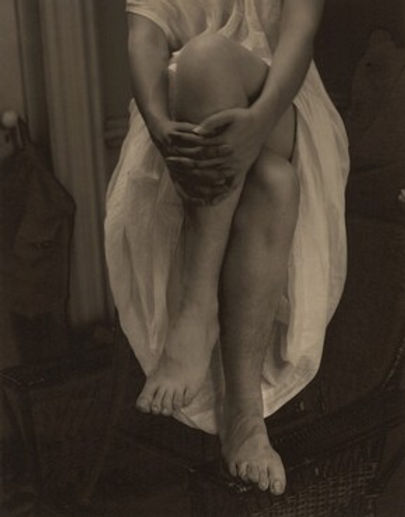
Alfred Stieglitz, Georgia O'Keeffe


Alfred Stieglitz, Georgia O'Keeffe

Alfred Stieglitz, Georgia O'Keeffe

Alfred Stieglitz, Georgia O'Keeffe

Alfred Stieglitz, Georgia O'Keeffe

Alfred Stieglitz, Georgia O'Keeffe

Alfred Stieglitz, Georgia O'Keeffe